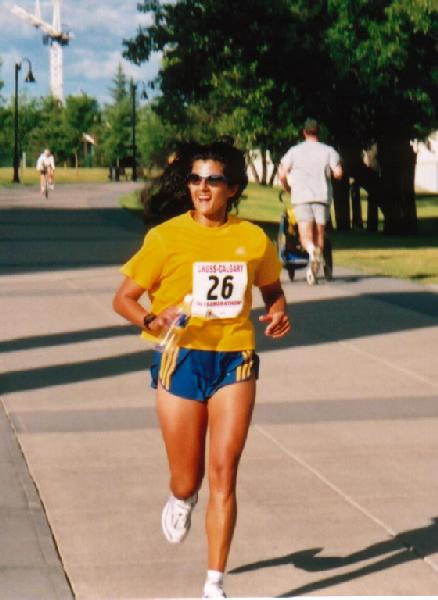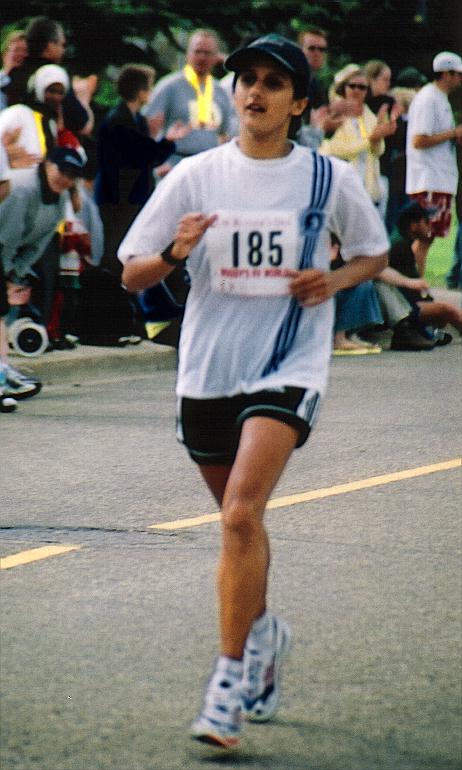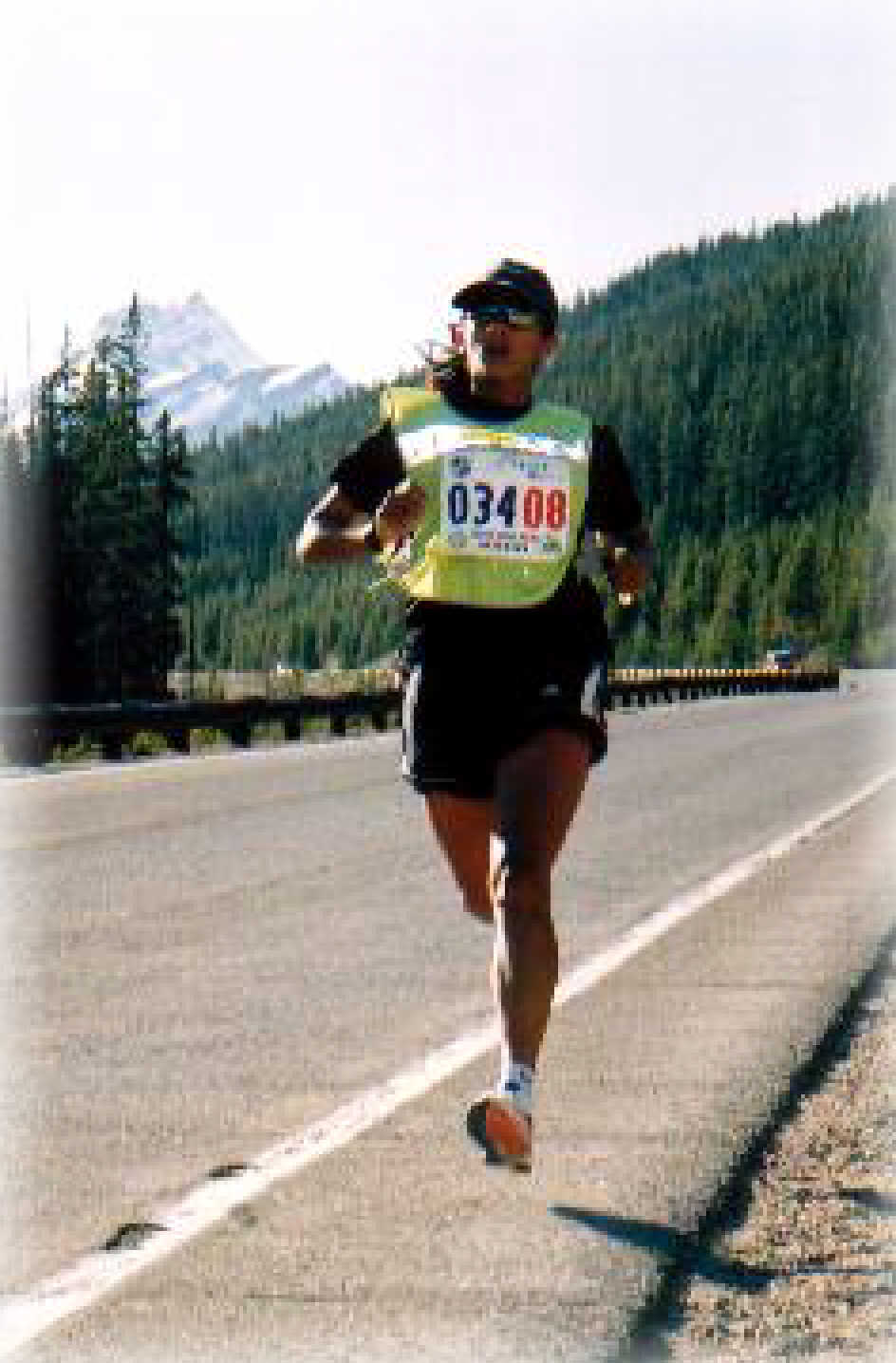|
Women in Motion
March 2001
Newsletter

enhancing
running performance
Vol 2.
Issue 7
March 2001
WOMEN
IN MOTION NEWSLETTER - March 2001
Vol. 2, No. 7
This
Month Contains:
~News
~Articles
Sports Bras
~From
Around the 'Net
1. Winter Running, What To Wear?
2. Getting Ready for Physical Activity
3. Calculating Your Calorie Demands
4. Nutrition and
Muscle Recovery
5. Getting Older
6. Cold Weather Precautions
~Words
of Inspiration
~The Running Woman Board
-The Runner's Club
Survey
Results
Women
in Motion February Survey: What is your running
focus for 2001?
The
responses were as follows:
| What is Your Running Focus For
2001? |
| |
Learn to Run |
25% |
 |
| |
Distance and/or Speed |
0% |
|
| |
Short Races: 5K 10K |
50% |
 |
| |
Middle Races: 10M Half Marathon
|
12% |
 |
| |
Long Races: Full Marathon,
Ultramarathon |
12% |
 |
| |
Join us
in March for a new survey.
|
Advance Article:
Sports Bras
Women of all sizes struggle
to be comfortable when walking or
jogging. Whether the problem is support,
chafing, or slipping straps, using the
right bra is the key to the solution.
The Jogbra was invented in 1977 by
Hinda Miller and a friend, who went to
their campus bookstore, bought two
jockstraps and sewed them together.
Champion
Jogbra continues to be the most
often-mentioned sports bra by female
runners.. Champion's website includes a
self-test to see how much motion-control
you want and what other features you
prefer in a sports bra. Their MCR Fit
Center guides you to the best bra for
your activity. They give special
attention to classic compression, natural
shaping, strap comfort, underwire support
and moisture control.
Reasons for using a jogging bra over a
conventional bra.
1. To avoid the strap attack:
Straps that don't stay on the
shoulders when you are in motion. Straps
that don't work well with your backpack,
resulting in double-rubbing. Most
manufacturers offer T-back or racer-back
designs that keep the straps from
slipping off the shoulders. Wider straps
can help distribute the weight, resulting
in less digging-in.
2. To stay hooked:
Motion can cause hooks to unhook,
especially if wearing a backpack with a
back-hooking bra. One solution commonly
seen are racer-back bras without hooks,
they just slip on over the head. The
problem then becomes how to get the wet,
sweat-soaked bra off after a good walk.
3. To control moisture:
Many sports bras/tops designed for
aerobic workouts are mostly cotton. For
running, look for a wicking fabric such
as CoolMax or polypropylene in a sports
bra.
4. For appearance:
You may want a sports bra that can be
worn as your only top in public rather
than one which says
"underwear." This gives you the
flexibility to take your overshirt off if
you overheat. Most sports bras come in a
variety of colors and patterns. Check for
whether the fabric is opaque even when
wet and if the fabric pattern or texture
hides the nipples enough for your
personal modesty.
5. To provide motion control without
compression:
You want everything to be held to
avoid the 'bounce', but you also want to
avoid having difficulty breathing. It
takes more than spandex to control motion
for larger cup sizes. Motion control is
evolving but it can be difficult to find
the perfect motion control bra.
6. To control chafing:
Where there is sweat and motion, there
is chafing. A sports bra can prevent
chafing by reducing the rubbing. Some
sports bras put the seams on the outside
to prevent chafing. Going braless
altogether is not an option unless you
take steps to tape your nipples to
prevent chafing and bleeding, a problem
also encountered by male runners.
Vasoline or BodyGlide will help.
7. To provide support:
Many women require a well-constructed,
underwire bra even when on the trail.
Light spandex tops are not enough.
Which bra and style you choose depends
on which problems you need to solve. The
worst problem is among those of a larger
cup size trying to find a bra that
supports and controls motion without too
much constriction.
A company dedicated to activewear for
larger women won kudos for their sports
bras, Junonia:
activewear for women size 14 and up.
For the smaller-breasted woman, the
constriction of the average
cotton/spandex sports bra can produce
flattening rather than flattering
results. Comfort vs. appearance can be a
real tradeoff. Some exercise tops are now
coming with Wonderbra-like inserts and
underwires to provide more shape. Women
who have had mastectomies have special
needs. Whether to wear a prosthesis,
especially to provide balance, is a
consideration, as well as choosing a
sports bra that will accommodate the
prosthesis.
Whatever sports bra you choose, be
sure to buy enough to allow for laundry
without interrupting your running
routine. Consider air drying the jogging
bra and then fluffing it in the cool
dryer.
Sports Bra sites:
1. Champion
Jogbra: Site lets you choose the
features you need and then gives you a
product recommendation.
2. Junonia:
activewear for women size 14 and up.
3. Support
Team Sports Bras
4. Enell
Sports Bra
5. Title
9 Sports Bras: Site has a good
selection index based on cup size.
6. X-Chrom
They support EVERY body. Good
selection for larger sizes.
7. Gear
and Clothing Net Links
Good luck and great runs.
Gord
|
|
|
From Around the 'Net
enhancing running performance







1. Winter Running, What To Wear? by Nick Greco
Winter is a beautiful time to run as long as you are
properly dressed for
the conditions. Temperatures can range from below zero to
60 degrees.
Snow, wind and rain add another challenge. So how do you
know what to
wear? The goal is to wear enough clothing to prevent you
from becoming
uncomfortable during your run. Too much clothing, or the
wrong material,
and you will be drenched in sweat and feel chilled. Too
little and you'll
be cold throughout the run. Below are some
guidelines that should help:
Dress in layers
Layer 1-Next to Your Skin (top and bottom)
The most important layer
Purpose: to wick moisture away from your skin to
Evaporate your perspiration
Keep you dry, comfortable and chill-free
Cotton absorbs moisture rapidly and dries very
slowly
Transfers heat away from your body
Leaves you chilled and clammy
Polyester wicks moisture away from your skin and
feels great close to
your body.
Lightweight
Very breathable
Some names to look for
Dri-F.I.T (functional innovative technology)
DriOn with O.F.T. (odor fighting thread)
Lightweight DryLite
Layer 2- Shell
Water resistant windproof vest
Water resistant windproof jacket
Wind pants
Layer 3- Thermal
Fleece shirt
Fleece or medium weight tights
Climate Control
40 - 60 degrees - One layer should be enough
Layer one
Short-sleeved shirt and shorts
Lightweight long-sleeved shirt
Lightweight tights
Layer two - Shell
Wear a water resistant, windproof vest if it is
windy or wet
Light weight gloves
Headband or hat
CoolMax socks - double layer
10 - 40 degrees - Two layers
Layer one:
Long-sleeved shirt
Medium-weight tights
Layer Two - Shell
Water resistant, windproof jacket
Gloves and mittens
Hat or cap
Ear band
CoolMax socks - double layer
10 degrees and below - Three layers
Layer one
Long-sleeved shirt
Long underwear
Layer two- Thermal
Fleece shirt
Fleece or medium weight tights
Layer 2- Shell
Water resistant windproof jacket
Wind pants
Gloves and mittens
Hat/cap
Neck gaiter
CoolMax socks - double layer
Important Things to Consider
1. Perspiration moves more easily through two thin layers
than through one
thick layer.
2. Breathable fabrics wick perspiration away from your
skin and pass it to
the next layer. One wrong piece (non-breathable) and the
whole system
breaks down, i.e., unpleasant running in heavy damp
clothing.
3. More than fifty percent of body heat is lost through
your head- wear a
cap/hat under 40 degrees.
4. Use a good face cream on your face on cold, windy
days.
5. If you feel comfortable before you run, you are
probably overdressed.
You should feel chilly during your first mile or even
before you begin to
run.
6. Take extra care of your fingertips, ears and feet in
cold temperatures.
There is little blood flow to those areas, which make
them susceptible to
frostbite.
7. Don't forget to drink. You could get dehydrated in the
winter as well
as the summer.
2. Getting Ready for Physical Activity
Before beginning any type of physical activity program,
you should
have a physical examination by your personal physician.
The following
questions are designed as a first step in your planning
to increase
the amount of physical activity in your life:
- Has a doctor ever said that you have a heart
condition and
recommended only medically supervised activity?
- Do you have chest pain brought on by physical activity?
- Have you developed chest pain in the past month?
- Do you tend to lose consciousness or fall over as a
result of
dizziness?
- Do you have a bone or joint problem that could be
aggravated by the
proposed physical activity?
- Has a doctor ever recommended medication for your blood
pressure or
a heart condition?
- Are you aware through your own experience, or a
doctor's advice, of
any other physical reason against your exercising without
medical
supervision?
If you answer "yes" to one or more questions,
consult with your
personal physician before increasing your physical
activity.
3. Calculating Your Calorie Demands.
Multiply your weight in pounds times ten. This
gives you your basal
calorie demand - what your body needs to do its basic
work. Multiply that
number by an activity factor - 50% for most regular
runners who are very
active. Add the result to your baseline needs and you
have a pretty good
estimate of your calorie needs for a day. A 150-pound
runner's basal
calorie demand is 1,500, plus an additional 750 calories
to fuel running,
for 2,250 a day. If 25% or 30% of calories come
from fat, that would be
70 to 85 grams of fat a day.
-From American Running Association's Running & Fit
News, January 2001, p. 3
4. Nutrition and
Muscle Recovery
In his book,
"Optimal Muscle Recovery", Dr. Edmund Burke,
Ph.D. writes
about the importance of the role of nutrition in helping
the muscles
to recover from exercise lasting more than sixty minutes.
He stresses
the importance of taking rest and nutrition as seriously
as taking the
training part of your sport. Dr. Burke has developed the
R4 System
based on four scientific principles for individual
performance:
- Restore Electrolytes and Water.
Electrolytes, usually added to
sports drinks, can accelerate re-hydration resulting in
quicker
re-absorption and retention of fluids.
- Replenish Glycogen Stores Rapidly. The recovery
ratio should be
4 grams of carbohydrates to 1 gram of protein during
the two-hour
post-exercise period.
- Reduce Oxidative and Muscle Stress. Antioxidants
such as vitamin C
and E have been shown to reduce free radical buildup
during exercise
and protect against muscle damage.
- Rebuild muscle protein. Supplementing the diet
with additional
glutamine can enhance muscle performance.
5. Getting Older
"Instead of
decreasing your average training speed as you get older,
gradually increase the percentage of training miles that
you run at 10-K
race pace or faster. Be careful to keep plenty of rest
days in the mix,
too. Jogging doesn't maintain "young
legs." You must do
high-quality work for that to occur." - Eileen
Portz-Shovlin, RW senior
editor
6. Cold Weather
Precautions
You can workout safely during cold weather by following
these
precautions:
- Check out the wind chill and temperature before
going out. Stay
indoors if conditions are extreme.
- Dress in layers that you can easily remove. If you
become cool, you
can always put on more clothing.
- Wear synthetic fabrics that keep moisture away from your
skin. You
don't want to become chilled.
- Wear a hat. Most heat loss is through the head.
- Wear mittens or socks to keep your hands warm--gloves
isolate your
fingers ultimately losing heat.
- Wear bright colored and reflective clothes. Anticipate
that drivers
may not be able to see you or stop quickly.
- Change your workout time so that you do not exercise in
the dark.
- Head into the wind. You want to end your workout with
the wind at
your back when you are sweating the most.
- Drink plenty of water. You need water to prevent
dehydration in the
winter just as in the summer.
- Watch out for slippery surfaces. Exercise with a friend
since the
chances of injury are greater due to icy conditions.
- Take longer warm ups if needed. In cold weather,
strains and sprains
are more likely to occur if your muscles are not warmed
up properly.
- Protect your skin. Use moisturizers before and after
exercise.
- If you are shivering, add another layer of clothing,
drink warm
liquids, or get inside and warm up.
- Always check with your physician before your begin an
exercise
program.
Words of Inspiration
"If you feel
bad at 10 miles, you're in trouble.
If you feel bad at 20 miles, you're normal. If you don't
feel bad at 26
miles, you're abnormal." --Rob de
Castella, Australian marathoner who
won the gold medal in the 1983 World Championship race
.
The
Running Woman Message Board in Diet and Fitness
The
Running Woman Message board continues to be active. It
continues a steady pickup in volume, hopefully because of
the interest in using running as part of a renewed
lifestyle. Let's hope they connect with the benefits of
running. We continue to offer advise to all posts. Thanks
to all of you who have provided assistance to members old
and new. Good Luck and Continued Running to all.
Gord
The
Runner's Club
The
RUNNER'S CLUB is still quiet, but with the number of
members just over 650. If you are a member, please take
the time to ensure that your email address is the one you
want to use. Members with incorrect email address will be
deleted from the membership as we are unable to contact
them with club information. The last email sent did
return 180 undeliverable messages back to my mailbox.
A continual reminder that two features of the CLUB are
the ability of members to communicate with each other
privately in the CLUB and the ability to arrange to chat
with each other in the 24 hour chat facility.
Members
have been asked to post on the calendar, their upcoming
race events for the year.
Good Luck and Great Runs
Gord
About
This Newsletter
A reminder that experts - we are not. Information
presented here is a collection of research with a taste
of experience and opinion added for flavour. We don't get
upset if someone disagrees with anything that has been
said or written. In our experience with running groups
here at home, it is difficult to get agreement on most
anything. If it works for you, then it works.
Neither Women in Motion nor the author of this newsletter
provides professional medical advice. The information in
this newsletter is intended to help you better understand
running issues. It is not intended to replace the advice
of a physician. If you read something in the newsletter
that contradicts what your physician tells you in any
way, always follow your physician's advice.
SUBSCRIBE/UNSUBSCRIBE INFO
You are receiving access to this newsletter because you
have subscribed via Listbot. If you do not wish to have
future newletters sent to you, please use that same
system found on the home page to unsubscribe.
If you have any suggestions for topics or questions
please email us. We would like to publish a monthly
newsletter that reflects the interests of the female
runner.
Gordon Samson, Editor
Women in Motion
LEGAL STUFF / SUBSCRIPTION INFO.
"Women in Motion Newsletter" is free, but its
articles are
copyrighted. No one may use the content without
permission of
the author and "Women in Motion". So please let
us know if you
think the information here is important enough to be
re-written.
Spread the Word
Tell your friends they can get the email link to this
free monthly newsletter.
Gordon and Fariyal Samson
Women in Motion
Visit us at
womeninmotion.ca
Practice
doesn't make perfect, perfect practice makes perfect.
-Fariyal Samson, B.PE, B.Ed
© Women in Motion
 Women in Motion March 2001
Women in Motion March 2001






